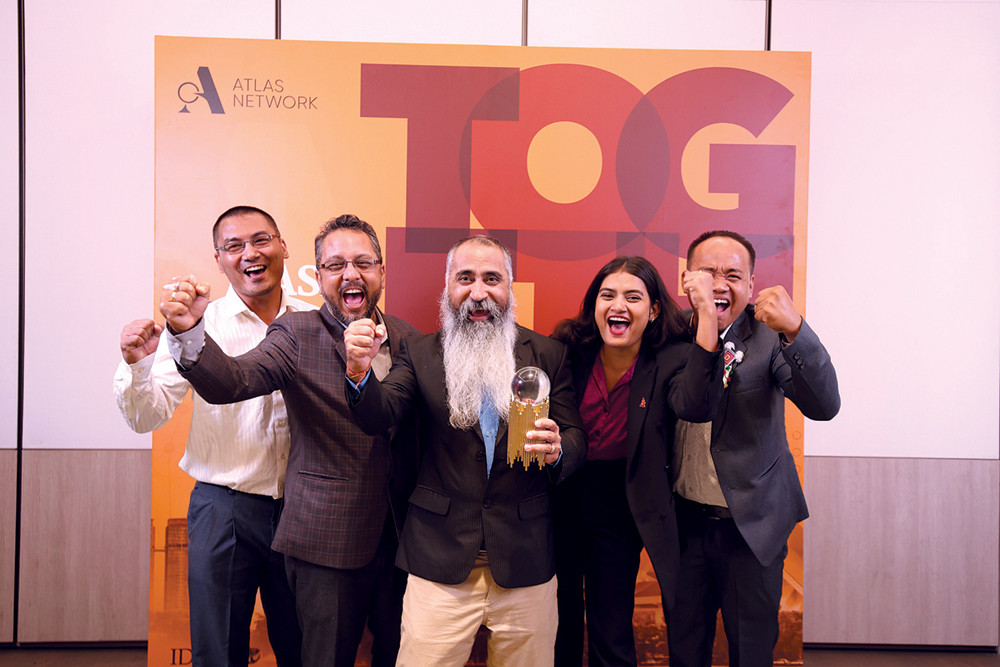
Citizens’ good health has positive and significant impacts on economic growth of a nation. Researchers from Harvard T.H. Chan School of Public Health, in a 2001 study, found that a one-year advancement in society’s life expectancy increases output by four percent. Though researches afterwards have confirmed varying relationship between health and economic growth across the countries, no one can deny their affirmative link in developing economies like Nepal. Despite these potentials, healthcare services in Nepal and other similar countries are plagued due to four key reasons – complicated geography, inadequate trained human capital, insufficient awareness among people and most importantly government’s low priority in healthcare investments. Since traditional healthcare models in the country have not been able to yield desired outcomes, maybe its time for public and private stakeholders to reconsider old approaches, devise new models that have potentials to deliver quality services to Nepalis across the country.
 Jaya Jung Mahat, an alumnus of the Lee Kuan Yew School of Public Policy at the National University of Singapore, is a Kathmandu-based public policy researcher. He writes extensively on issues that connect economics, politics and innovation. He can be reached at [email protected]
Jaya Jung Mahat, an alumnus of the Lee Kuan Yew School of Public Policy at the National University of Singapore, is a Kathmandu-based public policy researcher. He writes extensively on issues that connect economics, politics and innovation. He can be reached at [email protected]
Assessment of Nepal’s Healthcare System
More than 80 percent Nepalis still live in rural communities where access to healthcare services is limited. This limitation is mostly visible in terms of inadequate infrastructures, trained medical professionals and supply of basic life saving medicines. In recent years, the existing health posts and hospitals across the country have not being able to meet increasing demands of curative care services. According to a 2013 research done by Society for Local Integrated Development Nepal and Health Research And Social Development Forum, Nepal still lags behind when it comes to meeting World Health Organisation recommendations (WHO). For example, Nepal has 0.67 doctors and nurses - 0.17 doctors and 0.50 nurses - per 1000 Nepalis against WHO recommendation of 2.3 doctors, nurses, and midwives per 1000 individuals. There are about 196 institutions that offer more than 390 health-related training courses in Nepal and between 2009 and 2011 altogether they had produced more than 32,000 health workers - including 7,099 doctors and 8,681 nurses. From government investments perspective, as of 2014, Nepal’s total health expenditure as percentage of GDP stood at 5.8 percent against global average of 9.94 percent. Similarly, Nepal’s health expenditure per capita lags behind world average by a large margin - $ 40 against $1060. In recent years, the private sector has become an integral part of the country’s healthcare system. According to a cover story on healthcare system in Nepal in Business360°’s December 2016 Issue, private sector – with an investment of 5-6 billion and 15,000 human capital – has established half of the existing hospitals and provides almost double the numbers of beds as compared to those from government side and provides services to 50 percent of total patients. According to WHO, Nepal’s healthy life expectancy in 2015 was 61.1 years against life expectancy at birth of 67.7 years and 70.8 years for men and women respectively.This decline in life expectancy can be explained on the basis of country’s poor performance in other areas of healthcare system. Except in preventing incidents of Tuberculosis, Malarial and HIV infection among adults; country’s performance in other areas – including proportion of population using improved sanitation, proportion of births attended by skilled health personnel, maternal mortality rate, mortality rate attributed to exposure to unsafe WASH services, under five mortality and neonatal mortality rates and prevalence of stunning among them – are not satisfactory in terms of achieving national health goals and also meeting the SDGs targets.Global Good Practices
Over the years, there has been an increasing trend in the global numbers of chronic disease and dementia patients for whom the medical care is considerably expensive. Similarly, the rising trends in aging population, labor costs, communicable disease patients worldwide are also to threaten affordability of future healthcare. As a consequence, governments internationally need to increase healthcare spending as parentage of GDP to 10.5 percent 2020. According to Deloitte’s Global Health Care Sector Outlook report 2017, the world is expected to see increase in global healthcare spending to $8.7 trillion in 2020 from $7 trillion in 2015. In the light of rising healthcare costs and emerging health threats, public and private actors in different parts of the world have been employing innovative ways in order reach out to larger beneficiaries, minimise related costs and maximise efficiency through incorporation of one or more of these ten healthcare innovations - Next-Generation Sequencing, 3D-Printed Devices, Immunotherapy, Artificial Intelligence, Point-of-Care, Virtual Reality, Biosensors and Trackers, Convenient Care, Telehealth and Social Media - into their business models. The “American Well” (AE) in Boston, USA is one of such examples and its functions are based on the concept of telehealth. Currently active in 46 US States, AE employs doctor-to-consumer (DTC) model and connect patients directly with the doctors online in order to deliver quality services at lower costs. In order to run business smoothly, AE has also managed to bring together all key actors in American Healthcare System - Patients, service providers (hospitals, nursing homes and clinics), public and private payors (insurance companies, banks), suppliers (pharmaceutical companies, healthcare information technology companies, private equity and venture capitalists). The Arvind Eye Hospitals in Tamil Nadu, India is another example of an innovative healthcare model – Arvind Model - that has played crucial role in fighting cataract in India. According to the data released by the Hospital, it has treated more than 32 million patients and has performed over 4 million surgeries.Created in 1976, the Arvind Model comprises of activities at three centers - Main Hospital, Free Hospitals and Eye-Camps. Hospital personnel regularly participate in partners funded eye-camps in new places from where they refer genuine patients to either Free Hospitals for free treatments or the Main Hospital for paid services depending upon economic statuses of the patients. In addition, they also rotate duty hours of health workers between free and paid wards. To minimise the costs of the services, he hospital has its own lens manufacturing facility and blood bank. Additional examples of innovative healthcare initiatives outside Nepal include TelaDoc and ReduClinic in the USA, One Family Health and Child and Family Wellness Clinics in Rwanda, HCG Oncology and Deccan Hospital in India and Beijing Genomics Institute in China.Current Efforts and Future Potentials in Nepal
In order to properly address emerging health issues and also to resolve prevailing health problems in better and cheaper means, public and private sector stakeholders in Nepal should focus on working on prevention, diagnosis, monitoring and treatment parts of the healthcare ecosystem. In recent years, some of the old hospitals have upgraded their ecosystems and other created entire new company to deal with Nepal’s health issues in innovative ways. Some of these examples include - Tilganga Eye Hospital, Patan Hospital Telemedicine Facility, Possible Health and Health at Home. However, there is still enough room for few more new actors to enter the market, contribute their parts while earning profits. Considering poor performance of Nepal’s traditional healthcare models, recent technological disruptions, their penetration rates in Nepal, improving internet connectivity and existing barriers to better healthcare services, I can think of enough reasons for public and private sector stakeholders to invest in innovations in order to strengthen national healthcare ecosystem and also to increase people’s access to quality and affordable health services in their local communities. Jaya Jung Mahat, an alumnus of the Lee Kuan Yew School of Public Policy at the National University of Singapore, is a Kathmandu-based public policy researcher. He writes extensively on issues that connect economics, politics and innovation. He can be reached at [email protected]
Jaya Jung Mahat, an alumnus of the Lee Kuan Yew School of Public Policy at the National University of Singapore, is a Kathmandu-based public policy researcher. He writes extensively on issues that connect economics, politics and innovation. He can be reached at [email protected]
Published Date: March 20, 2017, 12:00 am
Post Comment
E-Magazine

Click Here To Read Full Issue
RELATED Innovation

.jpg)


.jpg)